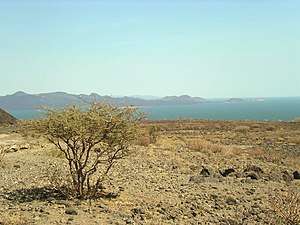Sibiloi National Park
Sibiloi National Park lies on the northeastern shore of Lake Turkana in northern Kenya. Established in 1973 by the government of Kenya for the protection of wildlife and paleontologist sites there, it covers 1,570 km2 (610 sq mi)[1] and is internationally known for its fossils. It was listed as a UNESCO World Heritage Site in 1997 as a part of Lake Turkana National Parks.
| Sibiloi National Park | |
|---|---|
IUCN category II (national park) | |
 | |
 Location of Sibiloi Nationalpark in Kenya | |
| Location | Eastern Province, Kenya |
| Coordinates | 03°57′38″N 36°20′33″E |
| Area | 1,570.85 km2 (606.51 sq mi)[1] |
| Established | 1973 |
| Governing body | Kenya Wildlife Service |
| Part of | Lake Turkana National Parks |
| Criteria | Natural: (viii)(x) |
| Reference | 801bis-001 |
| Inscription | 1997 (21st session) |
| Extensions | 2001 |
Background
The park was named for Mount Sibiloi in view at Alia Bay on the south perimeter. There also is located the park headquarters of the Kenya Wildlife Service, the administering authority; camping and short-stay facilities for visitors; and the Koobi Fora Museum. Koobi Fora Spit with the facilities of the Koobi Fora research Center are to the north, but are accessible through guided tours.
The most famous remains from the park are the Australopithecus and early Homo fossils. These have been moved to Nairobi, but fossil non-humanoids are on display in the museum.
See also
References
- World Database on Protected Areas – Sibiloi National Park
Documentation[create]
External links
- "Sibiloi National Park". Kenya Wildlife Service. Retrieved 2010-10-11.
